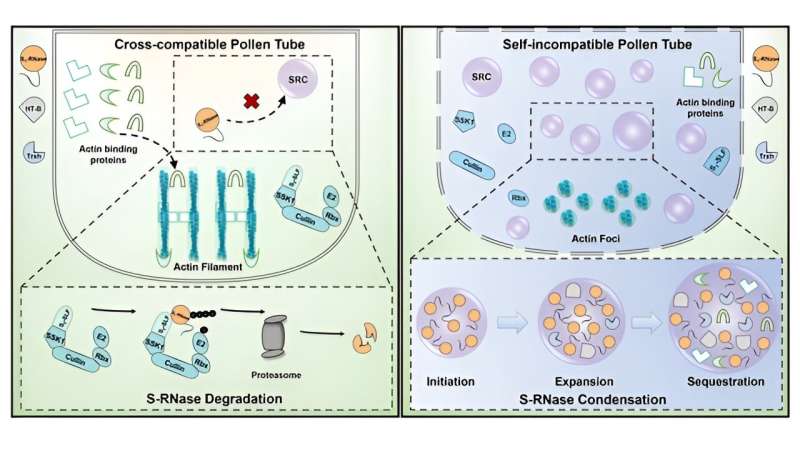This article has been reviewed according to Science X's editorial process and policies. Editors have highlighted the following attributes while ensuring the content's credibility:
fact-checked
trusted source
proofread
Chinese scientists reveal novel mechanism of angiosperm self-incompatibility

Self-incompatibility (SI) is a widespread intraspecific reproductive barrier in flowering plants, a system for rejecting self-pollen to prevent seed set after self-pollination. In Solanaceae, Plantaginaceae, Rosaceae, and Rutaceae, the SI system is controlled by a single polymorphic S-locus that encodes the linked pollen factor S-locus F-box box proteins (SLFs) and pistil factor S-RNase components.
Recent studies show that non-self S-RNase is degraded by the SCFSLF-mediated ubiquitin-proteasome system in Petunia, but how intact S-RNase functions in the self-pollen tube cytoplasm to elicit the self-incompatibility response remains unclear.
Researchers led by Prof. Xue Yongbiao from the Institute of Genetics and Developmental Biology (IGDB) of the Chinese Academy of Sciences have found that S-RNases form membrane-less puncta structures, called S-RNase condensates (SRCs), by phase separation in the cytoplasm of self- but not non-self-pollen tubes in Petunia hybrida. Further transgenic experiments showed that SRCs are required for the self-incompatibility response.
The researchers then confirmed the inhibitory or promoting effects of the pollen compatibility factors, the pistil incompatibility modifying factors HT-B and SSK1, and the redox state of the pollen tube on SRC formation.
In addition, the researchers also identified SRC-interacting components by in vitro SRC reconstruction and LC-MS to study SRC functions and found that the SRCs formed in self-pollen tubes mainly assemble and enrich actin-binding proteins such as PhABRACL, a promoter of actin polymerization.
Finally, the researchers found that SRCs indirectly affect the integrity of the self-pollen tube cytoskeleton integrity by sequestering actin-binding proteins.
The work was published in the Journal of Integrative Plant Biology.
Taken together, S-RNase initiates SRC formation by phase separation, HT-B and Trxh promote its expansion, which in turn sequesters actin-binding proteins, and then drives a self-incompatible response by indirectly interfering with the cytoskeletal organization in P. hybrida, uncovering a new mechanistic mode of SI in angiosperms.
More information: Huayang Tian et al, Phase separation of S‐RNase promotes self‐incompatibility in Petunia hybrida., Journal of Integrative Plant Biology (2023). DOI: 10.1111/jipb.13584
Provided by Chinese Academy of Sciences





















